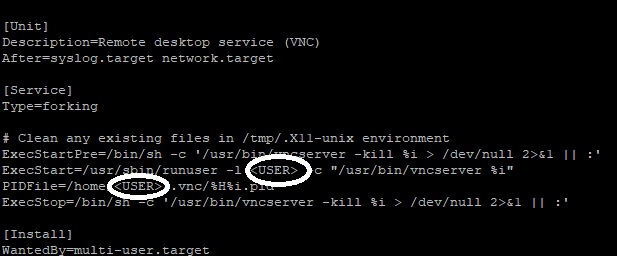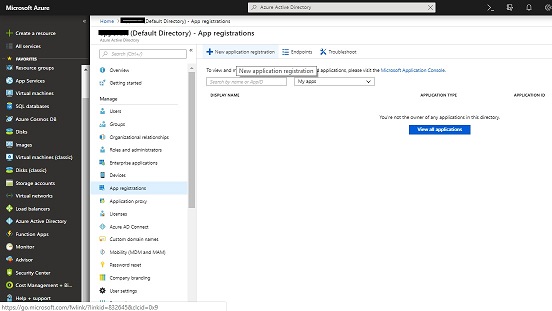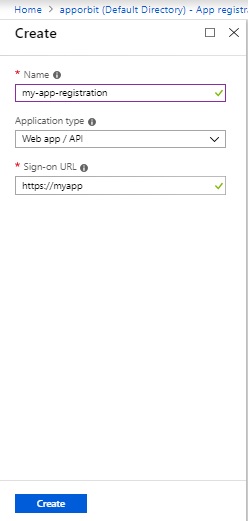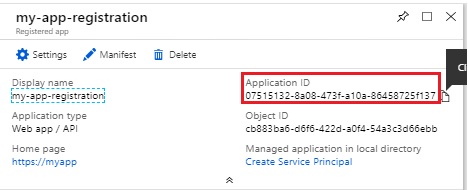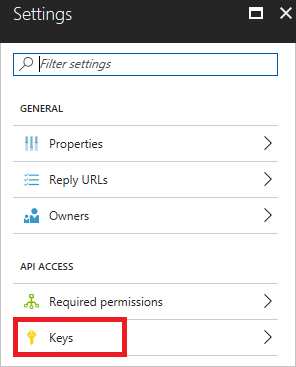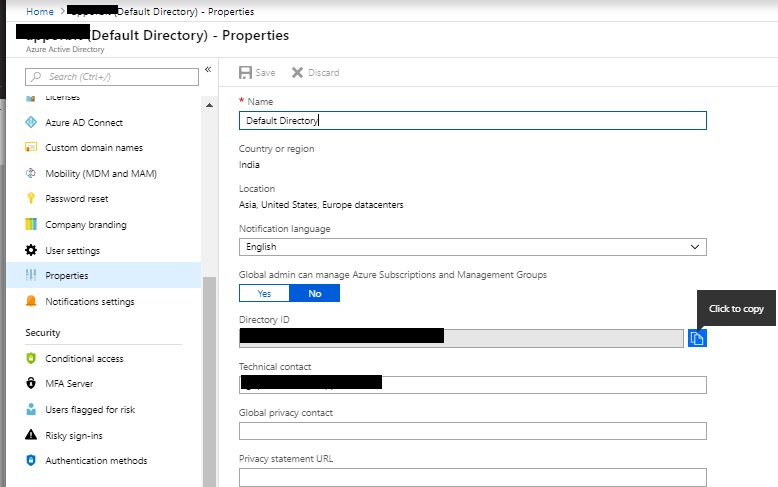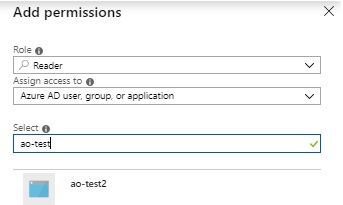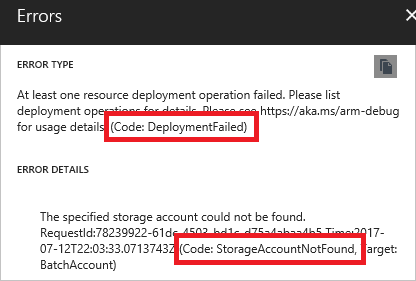| AcquireDiskLeaseFailed |
Failed to acquire lease while creating disk ‘{0}’ using blob with URI {1}. Blob is already in use. |
| AllocationFailed |
Allocation failed. Please try reducing the VM size or number of VMs, retry later, or try deploying to a different Availability Set or different Azure location. |
| AllocationFailed |
The VM allocation failed due to an internal error. Please retry later or try deploying to a different location. |
| ArtifactNotFound |
The VM extension with publisher ‘{0}’ and type ‘{1}’ could not be found in location ‘{2}’. |
| ArtifactNotFound |
Extension with publisher ‘{0}’, type ‘{1}’, and type handler version ‘{2}’ could not be found in the extension repository. |
| ArtifactVersionNotFound |
No version found in the artifact repository that satisfies the requested version ‘{0}’. |
| ArtifactVersionNotFound |
No version found in the artifact repository that satisfies the requested version ‘{0}’ for VM extension with publisher ‘{1}’ and type ‘{2}’. |
| AttachDiskWhileBeingDetached |
Cannot attach data disk ‘{0}’ to VM ‘{1}’ because the disk is currently being detached. Please wait until the disk is completely detached and then try again. |
| BadRequest |
Aligned’ Availability Sets are not yet supported in this region. |
| BadRequest |
Addition of a VM with managed disks to non-managed Availability Set or addition of a VM with blob based disks to managed Availability Set is not supported. Please create an Availability Set with ‘managed’ property set in order to add a VM with managed disks to it. |
| BadRequest |
Managed Disks are not supported in this region. |
| BadRequest |
Multiple VMExtensions per handler not supported for OS type ‘{0}’. VMExtension ‘{1}’ with handler ‘{2}’ already added or specified in input. |
| BadRequest |
Operation ‘{0}’ is not supported on Resource ‘{1}’ with managed disks. |
| CertificateImproperlyFormatted |
The secret’s JSON representation retrieved from {0} has a data field which is not a properly formatted PFX file, or the password provided does not decode the PFX file correctly. |
| CertificateImproperlyFormatted |
The data retrieved from {0} is not deserializable into JSON. |
| Conflict |
Disk resizing is allowed only when creating a VM or when the VM is deallocated. |
| ConflictingUserInput |
Disk ‘{0}’ cannot be attached as the disk is already owned by VM ‘{1}’. |
| ConflictingUserInput |
Source and destination resource groups are the same. |
| ConflictingUserInput |
Source and destination storage accounts for disk {0} are different. |
| ContainerAlreadyOnLease |
There is already a lease on the storage container holding the blob with URI {0}. |
| CrossSubscriptionMoveWithKeyVaultResources |
The Move resources request contains KeyVault resources which are referenced by one or more {0}s in the request. This is not supported currently in Cross subscription Move. Please check the error details for the KeyVault resource Ids. |
| DiagnosticsOperationInternalError |
An internal error occurred while processing diagnostics profile of VM {0}. |
| DiskBlobAlreadyInUseByAnotherDisk |
Blob {0} is already in use by another disk belonging to VM ‘{1}’. You can examine the blob metadata for the disk reference information. |
| DiskBlobNotFound |
Unable to find VHD blob with URI {0} for disk ‘{1}’. |
| DiskBlobNotFound |
Unable to find VHD blob with URI {0}. |
| DiskEncryptionKeySecretMissingTags |
{0} secret doesn’t have the {1} tags. Please update the secret version, add the required tags and retry. |
| DiskEncryptionKeySecretUnwrapFailed |
Unwrap of secret {0} value using key {1} failed. |
| DiskImageNotReady |
Disk image {0} is in {1} state. Please retry when image is ready. |
| DiskPreparationError |
One or more errors occurred while preparing VM disks. See disk instance view for details. |
| DiskProcessingError |
Disk processing halted as the VM has other disks in failed disks. |
| ImageBlobNotFound |
Unable to find VHD blob with URI {0} for disk ‘{1}’. |
| ImageBlobNotFound |
Unable to find VHD blob with URI {0}. |
| IncorrectDiskBlobType |
Disk blobs can only be of type page blob. Blob {0} for disk ‘{1}’ is of type block blob. |
| IncorrectDiskBlobType |
Disk blobs can only be of type page blob. Blob {0} is of type ‘{1}’. |
| IncorrectImageBlobType |
Disk blobs can only be of type page blob. Blob {0} for disk ‘{1}’ is of type block blob. |
| IncorrectImageBlobType |
Disk blobs can only be of type page blob. Blob {0} is of type ‘{1}’. |
| InternalOperationError |
Could not resolve storage account {0}. Please ensure it was created through the Storage Resource Provider in the same location as the compute resource. |
| InternalOperationError |
{0} goal seeking tasks failed. |
| InternalOperationError |
Error occurred in validating the network profile of VM ‘{0}’. |
| InvalidAccountType |
The AccountType {0} is invalid. |
| InvalidParameter |
The value of parameter {0} is invalid. |
| InvalidParameter |
The Admin password specified is not allowed. |
| InvalidParameter |
“The supplied password must be between {0}-{1} characters long and must satisfy at least {2} of password complexity requirements from the following:
- Contains an uppercase character
- Contains a lowercase character
- Contains a numeric digit
- Contains a special character.
|
| InvalidParameter |
The Admin Username specified is not allowed. |
| InvalidParameter |
Cannot attach an existing OS disk if the VM is created from a platform or user image. |
| InvalidParameter |
Container name {0} is invalid. Container names must be 3-63 characters in length and may contain only lower-case alphanumeric characters and hyphen. The hyphen must be preceded and followed by an alphanumeric character. |
| InvalidParameter |
Container name {0} in URL {1} is invalid. Container names must be 3-63 characters in length and may contain only lower-case alphanumeric characters and hyphen. The hyphen must be preceded and followed by an alphanumeric character. |
| InvalidParameter |
The blob name in URL {0} contains a slash. This is presently not supported for disks. |
| InvalidParameter |
The URI {0} does not look to be correct blob URI. |
| InvalidParameter |
A disk named ‘{0}’ already uses the same LUN: {1}. |
| InvalidParameter |
A disk named ‘{0}’ already exists. |
| InvalidParameter |
Cannot specify user image overrides for a disk already defined in the specified image reference. |
| InvalidParameter |
A disk named ‘{0}’ already uses the same VHD URL {1}. |
| InvalidParameter |
The specified fault domain count {0} must fall in the range {1} to {2}. |
| InvalidParameter |
The license type {0} is invalid. Valid license types are: Windows_Client or Windows_Server, case sensitive. |
| InvalidParameter |
Linux host name cannot exceed {0} characters in length or contain the following characters: {1}. |
| InvalidParameter |
Destination path for Ssh public keys is currently limited to its default value {0} due to a known issue in Linux provisioning agent. |
| InvalidParameter |
A disk at LUN {0} already exists. |
| InvalidParameter |
Subscription {0} of the request must match the subscription {1} contained in the managed disk id. |
| InvalidParameter |
Custom data in OSProfile must be in Base64 encoding and with a maximum length of {0} characters. |
| InvalidParameter |
Blob name in URL {0} must end with ‘{1}’ extension. |
| InvalidParameter |
{0}’ is not a valid captured VHD blob name prefix. A valid prefix matches regex ‘{1}’. |
| InvalidParameter |
Certificates cannot be added to your VM if the VM agent is not provisioned. |
| InvalidParameter |
A disk at LUN {0} already exists. |
| InvalidParameter |
Unable to create the VM because the requested size {0} is not available in the cluster where the availability set is currently allocated. The available sizes are {1}. Read more on VM resizing strategy at https://aka.ms/azure-resizevm. |
| InvalidParameter |
The requested VM size {0} is not available in the current region. The sizes available in the current region are {1}. Find out more on the available VM sizes in each region at https://aka.ms/azure-regions. |
| InvalidParameter |
The requested VM size {0} is not available in the current region. Find out more on the available VM sizes in each region at https://aka.ms/azure-regions. |
| InvalidParameter |
Windows admin username cannot be more than {0} characters long, end with a period(.), or contain the following characters: {1}. |
| InvalidParameter |
Windows computer name cannot be more than {0} characters long, be entirely numeric, or contain the following characters: {1}. |
| MissingMoveDependentResources |
The move resources request does not contain all the dependent resources. Please check error details for missing resource ids. |
| MoveResourcesHaveInvalidState |
The Move Resources request contains VMs which are associated with invalid storage accounts. Please check details for these resource ids and referenced storage account names. |
| MoveResourcesHavePendingOperations |
The move resources request contains resources for which an operation is pending. Please check details for these resource ids. Retry your operation once the pending operations complete. |
| MoveResourcesNotFound |
The move resources request contains resources that cannot be found. Please check details for these resource ids. |
| NetworkingInternalOperationError |
Unknown network allocation error. |
| NetworkingInternalOperationError |
Unknown network allocation error |
| NetworkingInternalOperationError |
An internal error occurred in the processing network profile of the VM. |
| NotFound |
The Availability Set {0} cannot be found. |
| NotFound |
Source Virtual Machine ‘{0}’ specified in the request does not exist in this Azure location. |
| NotFound |
Tenant with id {0} not found. |
| NotFound |
The Image {0} cannot be found. |
| NotSupported |
The license type is {0}, but the image blob {1} is not from on-premises. |
| OperationNotAllowed |
Availability Set {0} cannot be deleted. Before deleting an Availability Set please ensure that it does not contain any VM. |
| OperationNotAllowed |
Changing availability set SKU from ‘Aligned’ to ‘Classic’ is not allowed. |
| OperationNotAllowed |
Cannot modify extensions in the VM when the VM is not running. |
| OperationNotAllowed |
The Capture action is only supported on a Virtual Machine with blob based disks. Please use the ‘Image’ resource APIs to create an Image from a managed Virtual Machine. |
| OperationNotAllowed |
The resource {0} cannot be created from Image {1} until Image has been successfully created. |
| OperationNotAllowed |
Updates to encryptionSettings is not allowed when VM is allocated, Please retry after VM is deallocated |
| OperationNotAllowed |
Addition of a managed disk to a VM with blob based disks is not supported. |
| OperationNotAllowed |
The maximum number of data disks allowed to be attached to a VM of this size is {0}. |
| OperationNotAllowed |
Addition of a blob based disk to VM with managed disks is not supported. |
| OperationNotAllowed |
Operation ‘{0}’ is not allowed on Image ‘{1}’ since the Image is marked for deletion. You can only retry the Delete operation (or wait for an ongoing one to complete). |
| OperationNotAllowed |
Operation ‘{0}’ is not allowed on VM ‘{1}’ since the VM is generalized. |
| OperationNotAllowed |
Operation ‘{0}’ is not allowed as Restore point collection ‘{1}’ is marked for deletion. |
| OperationNotAllowed |
Operation ‘{0}’ is not allowed on VM extension ‘{1}’ since it is marked for deletion. You can only retry the Delete operation (or wait for an ongoing one to complete). |
| OperationNotAllowed |
Operation ‘{0}’ is not allowed since the Virtual Machines ‘{1}’ are being provisioned using the Image ‘{2}’. |
| OperationNotAllowed |
Operation ‘{0}’ is not allowed since the Virtual Machine ScaleSet ‘{1}’ is currently using the Image ‘{2}’. |
| OperationNotAllowed |
Operation ‘{0}’ is not allowed on VM ‘{1}’ since the VM is marked for deletion. You can only retry the Delete operation (or wait for an ongoing one to complete). |
| OperationNotAllowed |
Operation ‘{0}’ is not allowed on VM ‘{1}’ since the VM is either deallocated or marked to be deallocated. |
| OperationNotAllowed |
Operation ‘{0}’ is not allowed on VM ‘{1}’ since the VM is running. Please power off explicitly in case you shut down the VM from inside the guest operating system. |
| OperationNotAllowed |
Operation ‘{0}’ is not allowed on VM ‘{1}’ since the VM is not deallocated. |
| OperationNotAllowed |
Operation ‘{0}’ is not allowed on VM ‘{1}’ since VM has extension ‘{2}’ in failed state. |
| OperationNotAllowed |
Operation ‘{0}’ is not allowed on VM ‘{1}’ since another operation is in progress. |
| OperationNotAllowed |
The operation ‘{0}’ requires the Virtual Machine ‘{1}’ to be Generalized. |
| OperationNotAllowed |
The operation requires the VM to be running (or set to run). |
| OperationNotAllowed |
Disk with size {0}GB, which is smaller than the size {1}GB of the corresponding disk in Image, is not allowed. |
| OperationNotAllowed |
VM Scale Set extensions of handler ‘{0}’ can be added only at the time of VM Scale Set creation. |
| OperationNotAllowed |
VM Scale Set extensions of handler ‘{0}’ can be deleted only at the time of VM Scale Set deletion. |
| OperationNotAllowed |
VM ‘{0}’ is already using managed disks. |
| OperationNotAllowed |
VM ‘{0}’ belongs to ‘Classic’ availability set ‘{1}’. Please update the availability set to use ‘Aligned’ SKU and then retry the Conversion. |
| OperationNotAllowed |
VM created from Image cannot have blob based disks. All disks have to be managed disks. |
| OperationNotAllowed |
Capture operation cannot be completed because the VM is not generalized. |
| OperationNotAllowed |
Management operations on VM ‘{0}’ are disallowed because VM disks are being converted to managed disks. |
| OperationNotAllowed |
An ongoing operation is changing power state of Virtual Machine {0} to {1}. Please perform operation {2} after some time. |
| OperationNotAllowed |
Unable to add or update the VM. The requested VM size {0} may not be available in the existing allocation unit. Read more on VM resizing strategy at https://aka.ms/azure-resizevm. |
| OperationNotAllowed |
Unable to resize the VM because the requested size {0} is not available in the cluster where the availability set is currently allocated. The available sizes are: {1}. Read more on VM resizing strategy at https://aka.ms/azure-resizevm. |
| OperationNotAllowed |
Unable to resize the VM because the requested size {0} is not available in the cluster where the VM is currently allocated. To resize your VM to {1} please deallocate (this is Stop operation in the Azure portal) and try the resize operation again. Read more on VM resizing strategy at https://aka.ms/azure-resizevm. |
| OSProvisioningClientError |
OS Provisioning failed for VM ‘{0}’ because the guest OS is currently being provisioned. |
| OSProvisioningClientError |
OS provisioning for VM ‘{0}’ failed. Error details: {1} Make sure the image has been properly prepared (generalized).
|
| OSProvisioningClientError |
SSH host key generation failed. Error details: {0}. To resolve this issue verify if Linux agent is set up properly.
|
| OSProvisioningClientError |
Username specified for the VM is invalid for this Linux distribution. Error details: {0}. |
| OSProvisioningInternalError |
OS Provisioning failed for VM ‘{0}’ due to an internal error. |
| OSProvisioningTimedOut |
OS Provisioning for VM ‘{0}’ did not finish in the allotted time. The VM may still finish provisioning successfully. Please check provisioning state later. |
| OSProvisioningTimedOut |
OS Provisioning for VM ‘{0}’ did not finish in the allotted time. The VM may still finish provisioning successfully. Please check provisioning state later. Also, make sure the image has been properly prepared (generalized).
|
| OSProvisioningTimedOut |
OS Provisioning for VM ‘{0}’ did not finish in the allotted time. However, the VM guest agent was detected running. This suggests the guest OS has not been properly prepared to be used as a VM image (with CreateOption=FromImage). To resolve this issue, either use the VHD as is with CreateOption=Attach or prepare it properly for use as an image:
|
| OverConstrainedAllocationRequest |
The required VM size is not currently available in the selected location. |
| ResourceUpdateBlockedOnPlatformUpdate |
Resource cannot be updated at this time due to ongoing platform update. Please try again later. |
| StorageAccountLimitation |
Storage account ‘{0}’ does not support page blobs which are required to create disks. |
| StorageAccountLimitation |
Storage account ‘{0}’ has exceeded its allocated quota. |
| StorageAccountLocationMismatch |
Could not resolve storage account {0}. Please ensure it was created through the Storage Resource Provider in the same location as the compute resource. |
| StorageAccountNotFound |
Storage account {0} not found. Ensure storage account is not deleted and belongs to the same Azure location as the VM. |
| StorageAccountNotRecognized |
Please use a storage account managed by Storage Resource Provider. Use of {0} is not supported. |
| StorageAccountOperationInternalError |
Internal error occurred while accessing storage account {0}. |
| StorageAccountSubscriptionMismatch |
Storage account {0} doesn’t belong to subscription {1}. |
| StorageAccountTooBusy |
Storage account ‘{0}’ is too busy currently. Consider using another account. |
| StorageAccountTypeNotSupported |
Disk {0} uses {1} which is a Blob storage account. Please retry with General purpose storage account. |
| StorageAccountTypeNotSupported |
Storage account {0} is of {1} type. Boot Diagnostics supports {2} storage account types.
|
| SubscriptionNotAuthorizedForImage |
The subscription is not authorized. |
| TargetDiskBlobAlreadyExists |
Blob {0} already exists. Please provide a different blob URI to create a new blank data disk ‘{1}’. |
| TargetDiskBlobAlreadyExists |
Capture operation cannot continue because target image blob {0} already exists and the flag to overwrite VHD blobs is not set. Either delete the blob or set the flag to overwrite VHD blobs and retry. |
| TargetDiskBlobAlreadyExists |
Capture operation cannot continue because target image blob {0} has an active lease on it. |
| TargetDiskBlobAlreadyExists |
Blob {0} already exists. Please provide a different blob URI as target for disk ‘{1}’. |
| TooManyVMRedeploymentRequests |
Too many redeployment requests have been received for VM ‘{0}’ or the VMs in the same availability set with this VM. Please retry later. |
| VHDSizeInvalid |
The specified disk size value of {0} for disk ‘{1}’ with blob {2} is invalid. Disk size must be between {3} and {4}. |
| VMAgentStatusCommunicationError |
VM ‘{0}’ has not reported status for VM agent or extensions. Please verify the VM has a running VM agent and can establish outbound connections to Azure storage. |
| VMArtifactRepositoryInternalError |
An error occurred while communicating with the artifact repository to retrieve VM artifact details. |
| VMArtifactRepositoryInternalError |
An internal error occurred while retrieving the VM artifact data from the artifact repository. |
| VMExtensionHandlerNonTransientError |
Handler ‘{0}’ has reported failure for VM Extension ‘{1}’ with terminal error code ‘{2}’ and error message: ‘{3}’ |
| VMExtensionManagementInternalError |
Internal error occurred while processing VM extension ‘{0}’. |
| VMExtensionManagementInternalError |
Multiple errors occurred while preparing the VM extensions. See VM extension instance view for details. |
| VMExtensionProvisioningError |
VM has reported a failure when processing extension ‘{0}’. Error message: “{1}”. |
| VMExtensionProvisioningError |
Multiple VM extensions failed to be provisioned on the VM. Please see the VM extension instance view for details. |
| VMExtensionProvisioningTimeout |
Provisioning of VM extension ‘{0}’ has timed out. Extension installation may be taking too long, or extension status could not be obtained. |
| VMMarketplaceInvalidInput |
Creating a virtual machine from a non Marketplace image does not need Plan information, please remove the Plan information in the request. OS disk name is {0}. |
| VMMarketplaceInvalidInput |
The purchase information does not match. Unable to deploy from the Marketplace image. OS disk name is {0}. |
| VMMarketplaceInvalidInput |
Creating a virtual machine from Marketplace image requires Plan information in the request. OS disk name is {0}. |
| VMNotFound |
The VM ‘{0}’ cannot be found. |
| VMRedeploymentFailed |
VM ‘{0}’ redeployment failed due to an internal error. Please retry later. |
| VMRedeploymentTimedOut |
Redeployment of VM ‘{0}’ didn’t finish in the allotted time. It might finish successfully in some time. Else, you can retry the request. |
| VMStartTimedOut |
VM ‘{0}’ did not start in the allotted time. The VM may still start successfully. Please check the power state later. |

